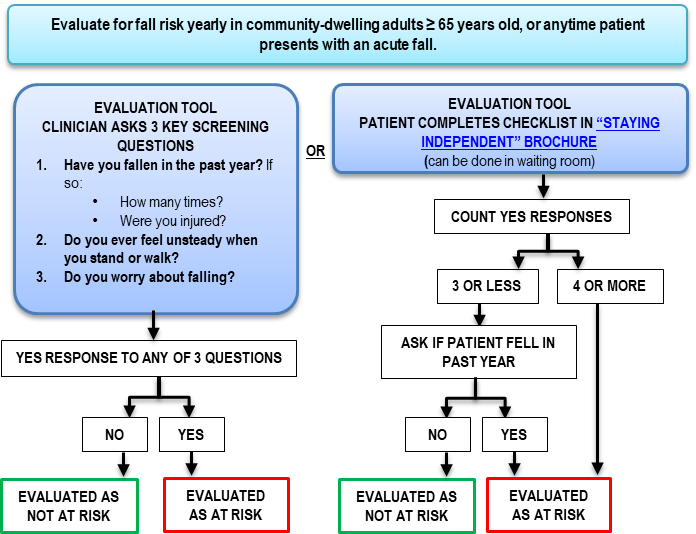10 Simple Techniques For Dementia Fall Risk
10 Simple Techniques For Dementia Fall Risk
Blog Article
The 9-Minute Rule for Dementia Fall Risk
Table of ContentsDementia Fall Risk - An OverviewDementia Fall Risk Can Be Fun For AnyoneRumored Buzz on Dementia Fall RiskExcitement About Dementia Fall Risk
A loss danger evaluation checks to see exactly how most likely it is that you will certainly drop. The assessment usually includes: This includes a collection of questions concerning your general wellness and if you've had previous falls or troubles with balance, standing, and/or strolling.Treatments are suggestions that may minimize your danger of dropping. STEADI consists of three steps: you for your risk of dropping for your risk aspects that can be enhanced to try to prevent drops (for example, balance issues, impaired vision) to decrease your threat of falling by using reliable approaches (for instance, giving education and sources), you may be asked a number of inquiries consisting of: Have you dropped in the past year? Are you fretted concerning dropping?
If it takes you 12 seconds or even more, it may indicate you are at higher risk for a fall. This examination checks stamina and equilibrium.
The placements will obtain tougher as you go. Stand with your feet side-by-side. Relocate one foot midway forward, so the instep is touching the huge toe of your other foot. Move one foot fully in front of the other, so the toes are touching the heel of your various other foot.
Facts About Dementia Fall Risk Uncovered
Most falls occur as an outcome of multiple adding elements; for that reason, managing the danger of dropping begins with recognizing the elements that add to fall threat - Dementia Fall Risk. Some of the most appropriate risk variables include: Background of prior fallsChronic clinical conditionsAcute illnessImpaired gait and equilibrium, reduced extremity weaknessCognitive impairmentChanges in visionCertain risky medicines and polypharmacyEnvironmental elements can additionally increase the danger for drops, consisting of: Poor lightingUneven or harmed flooringWet or slippery floorsMissing or harmed handrails and get barsDamaged or improperly fitted devices, such as beds, wheelchairs, or walkersImproper use assistive devicesInadequate supervision of individuals residing in the NF, consisting of those that display aggressive behaviorsA effective autumn danger administration program requires an extensive professional evaluation, with input from all members of the interdisciplinary team

The care plan ought to likewise include treatments that are system-based, such as those that promote a secure setting (suitable lighting, handrails, grab bars, etc). The efficiency of the interventions should be assessed occasionally, and the treatment plan revised as required to mirror modifications in the loss risk analysis. Applying a loss threat management system using evidence-based ideal method can decrease the prevalence of drops in the NF, while limiting the capacity for fall-related injuries.
About Dementia Fall Risk
The AGS/BGS standard advises evaluating all adults aged 65 years and older for loss threat yearly. This screening consists of asking individuals whether they have dropped 2 or more times in the past year or sought clinical attention for a loss, or, if they have actually not dropped, whether they feel unsteady when strolling.
Individuals that have fallen as soon as without injury should have their equilibrium blog here and gait assessed; those with stride or equilibrium abnormalities ought to obtain extra analysis. A history of 1 fall without injury and without gait or balance problems does not warrant more evaluation beyond ongoing yearly loss threat screening. Dementia Fall Risk. A loss risk analysis is called for as component of the Welcome to Medicare examination

Little Known Facts About Dementia Fall Risk.
Recording a drops history is one of the quality indications for fall prevention and administration. Psychoactive medicines in particular are independent predictors of falls.
Postural hypotension can often be minimized by decreasing the dosage of blood pressurelowering drugs and/or quiting medications that have orthostatic hypotension as a negative effects. Usage of above-the-knee support hose pipe and sleeping with the head of the bed elevated might also lower postural reductions in blood stress. The preferred elements of a fall-focused physical exam are shown in Box 1.

A TUG time greater than or equal to 12 seconds suggests high fall risk. Being unable to stand up from a chair of knee height without using one's arms shows raised autumn risk.
Report this page